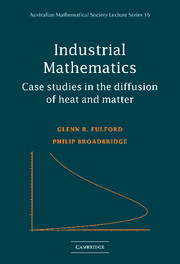2 - Case Study: Continuous Casting
Published online by Cambridge University Press: 14 January 2010
Summary
The case study in this chapter involves finding the puddle length in a continuous casting operation. This involves calculating how fast molten steel solidifies. We introduce the Boltzmann similarity transformation as a way of solving the 1-D heat equation with a moving boundary (the boundary between molten and solidified steel, which changes with time). This technique reduces the PDE into an ordinary differential equation (ODE) and a parameter describing the moving boundary position is obtained as the solution of a transcendental equation.
Introduction to the case study problem
Of great interest in many industrial applications are those problems which involve a change of phase — from solid to liquid or liquid to solid, for example. These are also interesting mathematically because few exact solutions are known. Hence the ones for which analytic solutions are known give considerable insight into the physical processes involved. We develop a mathematical model to examine the feasibility of casting steel sheets by pouring molten metal onto a cooled rotating drum. This model involves the concept of a moving solidification boundary. The problem was brought to the 1985 Australian Mathematics in Industry Workshop by the Research Laboratories of BHP in Melbourne. It was reported in Barton (1985).
Background
A conventional method of producing steel sheets involves rolling steel billets down to the required thickness. This can be costly in both resources and time. Also it is difficult to produce very long sheets of steel by this method. One alternative is to pour molten steel onto a rotating drum which is cooled by water flowing through it (see Figure 2.1.1).
- Type
- Chapter
- Information
- Industrial MathematicsCase Studies in the Diffusion of Heat and Matter, pp. 49 - 84Publisher: Cambridge University PressPrint publication year: 2001



